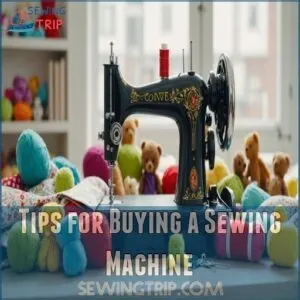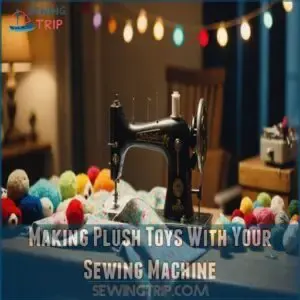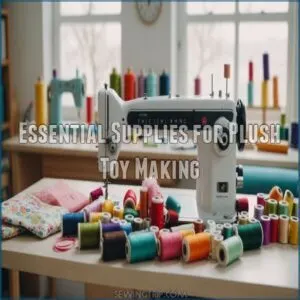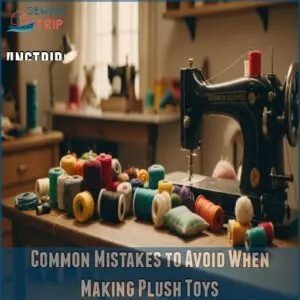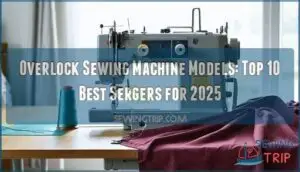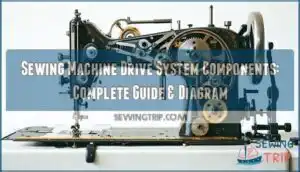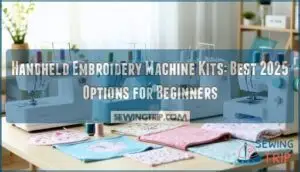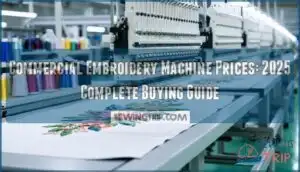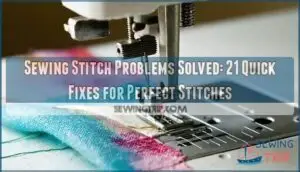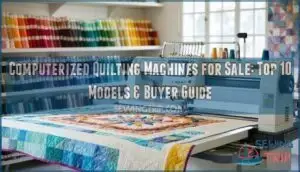This site is supported by our readers. We may earn a commission, at no cost to you, if you purchase through links.
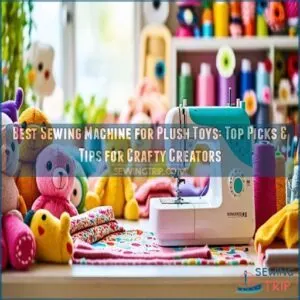 Finding the best sewing machine for plush toys can feel overwhelming, but it doesn’t have to be!
Finding the best sewing machine for plush toys can feel overwhelming, but it doesn’t have to be!
For durable, high-quality stitching, consider heavy-duty models like the Singer Heavy Duty or Brother XM2701. They handle thick fabrics with ease.
Look for features like an automatic needle threader—a lifesaver! And a sturdy metal frame guarantees longevity.
Don’t forget stitch options; a variety lets you personalize your creations. The right machine gives you the control and precision you need.
Want to know more about choosing the perfect fabric and mastering those tricky seams? Keep reading!
Table Of Contents
Key Takeaways
- You’ll find that the Singer Heavy Duty and Brother XM2701 are excellent for handling thick fabrics, thanks to their powerful motors and durable frames.
- Don’t underestimate the value of an automatic needle threader and a variety of stitch options; they will save you time and let you customize your projects.
- Always check the machine’s durability and customer support when shopping for a sewing machine to ensure it fits your plush toy crafting needs.
- Prioritize using high-quality materials and ensuring proper seam allowances to avoid common mistakes and create lasting plush companions.
Best Sewing Machines for Plush Toys
You’ll find the perfect sewing machine for creating plush toys among our top picks.
These machines offer the right features to handle thick fabrics and intricate details, making your plush toy projects a breeze.
1. Brother XM2701 Sewing Machine
For crafting plush toys, the Brother XM2701 is a real gem.
You’ll love its 27 built-in stitches, giving you plenty of options for your creations.
The automatic needle threader is a lifesaver, saving you time and frustration.
With a drop-in top bobbin and free arm, you’ll breeze through your projects.
It’s lightweight but durable, perfect for beginners and pros alike.
The best part? It won’t break the bank.
Sure, the LED light could be brighter, but for the price, you’re getting a reliable workhorse that’ll help bring your plush pals to life.
Best For: The Brother XM2701 is best for beginners and hobbyists who want a reliable and affordable sewing machine for a variety of projects.
- Easy to use with features like an automatic needle threader and drop-in bobbin.
- Versatile for a wide range of sewing projects, including plush toys.
- Durable and affordable.
- The LED light is not very bright.
- The presser foot lever may break with heavy use.
- Limited stitch options compared to more advanced machines.
2. Singer Heavy Duty Sewing Machine
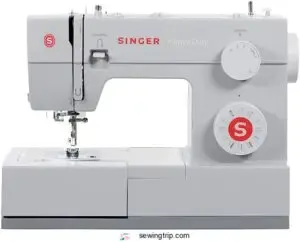
The Singer Heavy Duty Sewing Machine is a powerhouse for plush toy enthusiasts. You’ll love its 97 stitch applications and high-speed performance, churning out 1,100 stitches per minute. Its 60% stronger motor tackles thick fabrics with ease, while the heavy-duty metal frame keeps things stable.
The automatic needle threader and top drop-in bobbin make setup a breeze. However, some users report tension issues and tricky foot control.
To get the best results, use the felt bobbin spacer, plastic bobbins, and correct needle size. With a bit of practice, you’ll be stitching up a storm in no time.
Best For: Sewing enthusiasts who tackle heavy fabrics and need a robust machine for durable projects.
- Powerful motor handles thick fabrics with ease.
- Automatic needle threader and top drop-in bobbin simplify setup.
- Heavy-duty metal frame provides stability for demanding projects.
- Some users report thread tension issues and bobbin jams.
- Foot control can be challenging to manage for fine control.
- Manual may require additional research and video guidance.
3. Brother CS5055PRW Sewing Machine
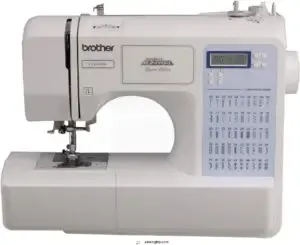
You’ll love the Brother CS5055PRW for plush toy crafting.
This powerhouse boasts 50 built-in stitches, including 5 auto-size buttonholes.
Its automatic needle threader and drop-in top bobbin make setup a breeze.
The LCD screen helps you navigate features easily.
With 7 sewing feet and a 3-piece needle set, you’re ready for any project.
It’s lightweight but durable, perfect for beginners and pros alike.
The machine’s versatility shines in quilting and basic repairs too.
While the semi-automatic threader takes practice, you’ll soon be stitching like a pro.
Best For: The Brother CS5055PRW is best for beginners and those who want a versatile machine for a variety of projects, especially quilting and plush toy crafting.
- Easy to use, even for beginners.
- Durable and can withstand accidental drops.
- Includes a variety of accessories, such as 7 sewing feet and a 3-piece needle set.
- The semi-automatic threader takes some getting used to.
- The bobbin reel is top loading, not side loading.
- The machine does not come with a case.
4. SINGER MX231 Sewing Machine with Accessory Kit
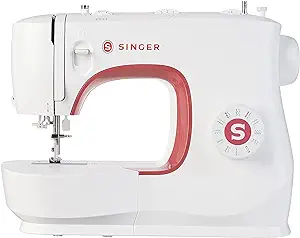
A plush toy creator’s dream, the SINGER MX231ing Machine is both versatile and user-friendly, making it suitable for kids learning to sew with its easy-to-use dial.
With 97 stitch applications, it’s perfect for your plush projects, while the adjustable stitch settings let you personalize each creation.
Despite its lightweight design, the machine boasts a durable metal frame, ensuring longevity and reliability.
Although some users find the plastic handwheel challenging and the missing instruction manual a hurdle, the included accessory kit and easy stitch selector dial make up for it, enhancing your sewing experience considerably.
Best For: The SINGER MX231 sewing machine is best for beginners, hobbyists, and those looking for a lightweight and affordable machine for basic sewing projects, but if you’re seeking a more advanced machine with features like 60 built-in stitches and four automatic one-step buttonholes. The SINGER MX231 sewing machine is best for beginners, hobbyists, and those looking for a lightweight and affordable machine for basic sewing projects.
- 97 stitch applications provide versatility for various projects.
- Easy stitch selector dial simplifies stitch selection.
- Durable metal frame ensures long-lasting use.
- Plastic handwheel can be difficult to use for reverse stitching.
- Missing instruction manual can be frustrating for some users.
- The self-threading needle might not always work reliably.
Tips for Buying a Sewing Machine
When buying a sewing machine for plush toys, focus on durability and the ability to handle heavy-duty stitching.
Consider the machine’s features, reputation, and customer support to make sure you get one that fits your crafting needs perfectly.
Durability and Heavy-Duty Stitching
Building plush toys requires a durable sewing machine.
You’re investing in motors that handle heavy-duty stitching and maintain stitch quality through thicker fabrics.
Consider the needles’ strength as they pierce fabric layers smoothly, ensuring seam durability.
Here’s what to look for:
- Strong motors for thick materials
- Quality stitches without skipping
- Sturdy needles that last
Brand Reputation and Customer Support
Choosing a sewing machine for plush toys should include looking at brand reputation and customer support.
Trustworthy brands like Brother, with models such as the CS5055PRW or XM2701, and Singer, with the MX231, offer robust warranty coverage and customer reviews.
Reliable repair services and community support can make a world of difference in your sewing adventures.
Features and Stitch Options
When considering a sewing machine for plush toys, focus on features like stitch types and options, including zigzag and embroidery stitches.
Make sure the machine offers decorative stitch choices and includes a buttonhole capability.
Look for enhancements like a walking foot or stretch needle, which can improve seam allowance handling.
Such features make the crafting process smoother and more enjoyable.
Automatic Needle Threader and Presser Foot Pressure
As you explore stitch options, consider a sewing machine with an automatic needle threader and adjustable presser foot pressure.
These features simplify sewing, especially with diverse fabrics and stitch types.
Enjoy benefits like:
- Needle threading: Quick and easy setup.
- Foot pressure: Adjust for fabric thickness.
- Universal needle: Versatile use across projects.
Choose wisely for stress-free sewing!
Making Plush Toys With Your Sewing Machine
Now you’re ready to bring your plush toy dreams to life!
We’ll guide you through choosing the right fabrics, cutting patterns precisely, and expertly sewing your creations together, ensuring a snug, stuffed friend.
Choosing The Right Fabric and Pattern
After exploring machine options, let’s talk fabric and patterns for your plush toy.
When searching for a sewing machine specifically designed for plush, consider checking out options like those found on Sewing Machines for Plush.
Choose a plush toy fabric like cotton fabric for softness and ease on your sewing machine.
Consider fabric weight to make sure your sewing skills match the task.
Opt for plush toy patterns with the right pattern complexity, sourced from reliable pattern sources, to suit your skill level.
Prepping Fabric and Cutting Pieces
Getting started with fabric for plush toys involves careful prep to make sure perfection.
Watch out for fabric shrinkage by washing first.
Use these steps for success:
- Pin your pattern to the fabric; use quilting gloves for grip.
- Use a rotary blade for cutting precision, especially with faux fur.
- Mark details on the fabric before cutting pieces to prevent fraying.
Sewing Pieces Together and Stuffing
Once your fabric pieces are cut, it’s time to stitch them with your sewing machine.
Make sure you have a 1/2-inch seam allowance for durability.
Straight stitches work wonders, but don’t forget to reinforce stress points.
Stuff your plush toy with lightweight polyester filling, using a pencil for snug spots.
To finish, master the ladder stitch for invisible closures.
Essential Supplies for Plush Toy Making
To make plush toys, you’ll need some essential supplies like soft, flexible fabrics and polyester fiberfill stuffing.
Don’t forget your all-purpose thread, sharp sewing needles, and templates made from pattern paper or cardboard to bring your creative designs to life.
Soft and Flexible Fabrics
Choosing the right fabric for your handmade plush toys sets the stage.
Soft and flexible fabrics bring life to your designs.
Consider these categories:
- Fabric Types: Opt for fleece or minky.
- Fabric Weights: Balance durability and ease.
- Fabric Textures: Choose smooth or textured.
- Fabric Care: Select wash-friendly materials.
These materials help your plush toy feel comfortable and charming.
Polyester Fiberfill Stuffing
Polyester fiberfill stuffing is essential for crafting plush toys that feel soft and cuddly.
You’ll want to explore stuffing alternatives, considering fiberfill density for the right touch.
Pay attention to safety concerns when choosing materials.
Store your stuffing properly to keep it clean and ready for your next diy plush toy project.
Explore plush toy ideas in your next creation!
All-Purpose Thread and Sharp Sewing Needles
Now that you’ve got your stuffing sorted, let’s talk thread and needles.
All-purpose thread, like a good friend, is versatile.
When shopping for supplies, consider checking out online marketplaces like plush toy sewing machines for all your crafting needs.
Choose a strong thread; thread tension is key for neat stitches.
Sharp needles are your best bet, especially for those fiddly bits.
Needle sizes vary; experiment to find what works best for your fabric.
Brands like Schmetz or Organ are popular choices.
Hand-sewing techniques are great for detail work.
Remember, the right tools make all the difference.
Pattern Paper and Cardboard Templates
Templates, like pattern paper and cardboard, are essential for plush toy precision.
You’ll need them for accuracy and easy adjustments in template scaling.
DIY templates keep things flexible, letting you experiment with designs.
Store them neatly for reuse.
Pair these with tools like a rotary cutter and pressing cloth for the best results.
Shannon fabrics? They’re perfect for plushies!
Common Mistakes to Avoid When Making Plush Toys
When making plush toys, it’s important to avoid common pitfalls that can impact the final product.
By steering clear of using low-quality materials, ignoring pre-shrinking fabric, and ensuring proper seam allowance and stuffing, you’ll create delightful and durable plush companions.
Using Low-Quality Materials
You’ve got all your supplies ready, but using low-quality materials can unravel your efforts fast.
Flimsy fabrics lead to quick seam fraying, affecting toy lifespan.
Prioritize fabric durability, and your stitching quality will shine.
To avoid common mistakes, it’s also essential to choose the right sewing machine needles for your fabric type.
Aim for good stuffing quality to make sure your plushies last.
Good tools, like a Cricut Maker or an embroidery machine, can elevate your craft.
Not Pre-Shrinking Fabric
Skipping fabric pre-shrinking can lead to unexpected shrinkage and misshaped plush toys.
Before sewing, wash your fabrics following specific pre-shrinking tips to maintain their size.
Different fabric types react differently to washing, so understanding these subtleties helps avoid common sewing mistakes.
Treat this like a gentle introduction to your plush masterpiece, ensuring it stays true to your vision.
Poor Seam Allowance and Stitching
Moving from preparing fabric, keeping a watchful eye on your seam allowance can make all the difference.
If you’re not careful, poor seam allowances lead to uneven plush toys.
Here are three tips:
- Maintain a consistent seam width.
- Ensure neat, tight stitching.
- Use seam ripping to fix errors and prevent fraying.
These sewing tips will guide you toward plush perfection every time.
Insufficient Stuffing and Closure
Getting your seams straight is one thing, but don’t shortchange on stuffing your plush toys.
Use proven stuffing techniques to guarantee filling consistency.
Additionally, consider investing in a specialized tool, such as the best machine for plush toys found at Best Plush Toys Machines, to help streamline your process.
Otherwise, your toy might end up lumpy or lose its shape over time.
Master closure methods like a ladder stitch to seal everything tightly, enhancing toy durability and guaranteeing your creations maintain their form and charm.
Frequently Asked Questions (FAQs)
How to choose a toy sewing machine for kids?
To choose a toy sewing machine for kids, prioritize safety features like finger guards and speed control.
Consider ease of use, stitch variety, and machine durability.
Opt for models with colorful designs to keep them engaged and inspired.
How to make cute plush toys for a child?
Did you know that plush toys can boost a child’s empathy skills by 30%?
Choose soft fabrics like fleece, cut your pieces carefully, sew them inside out, and stuff generously for a cuddly, huggable toy.
How do you sew a plush toy?
When sewing a plush toy, start by choosing a simple pattern.
Cut your fabric carefully.
Use a sewing machine for speed, but hand stitch small details for precision and charm.
How do you make a stuffed animal with a sewing machine?
Creating a stuffed animal carries the magic of beginning with patterns.
Use a sewing machine for precise stitches.
Leave a small opening for stuffing.
Finish it with careful closures.
What is the best sewing machine stitch for stuffed animals?
A straight stitch works great for most seams. For curves, a zigzag stitch prevents fraying. Experiment! You’ll find what works best for your projects and preferred fabric.
Can you sew a stuffed animal with a sewing machine?
You can definitely sew a stuffed animal with a sewing machine.
Choose a machine with adjustable stitch settings and a strong motor to handle plush fabrics.
Use a straight or zigzag stitch for durability and precision.
What is the best sewing machine for making teddy bears?
Imagine crafting teddy bears with ease using the Brother CS6000i sewing machine.
Its 60 built-in stitches guarantee seamless sewing.
The jam-resistant bobbin is like a master chef expertly whisking ingredients for a perfect dish, ensuring a smooth and trouble-free sewing experience with seamless sewing.
What type of stitch is used for plushies?
For plush toys, the most common stitches are the straight and zigzag stitches.
They serve different purposes in making plushies.
Use a straight stitch to sew pieces together securely.
Use a zigzag stitch to prevent fraying.
Both stitches ensure your plushies are both sturdy and neat.
How do I maintain my sewing machine?
Maintaining your sewing machine involves regularly cleaning lint and dust, oiling the moving parts, and occasionally changing the needle.
Follow the manual’s instructions for specific care details, ensuring longevity.
Avoid using canned air; it pushes debris deeper.
What is the best thread type for plushies?
Choose an all-purpose polyester thread for sewing plushies.
It’s durable, blends smoothly with plush fabrics, and offers flexibility.
This thread type makes for strong seams, reducing the risk of your plush toys coming apart during playtime.
Can children use sewing machines safely?
Children can safely use sewing machines with proper supervision and guidance.
They should start with a kid-friendly model that includes safety features like finger guards and speed control.
Always emphasize the importance of adult supervision and patience.
How do I troubleshoot bobbin issues?
Think of your sewing machine as a car where the bobbin is the engine.
Start with checking its tension and make sure the thread is wound evenly.
Clean the bobbin case and reinsert it correctly to prevent issues.
What are some advanced sewing techniques for plushies?
Explore advanced plushie sewing by mastering techniques like ladder stitching for seamless closures.
These methods elevate your creations, giving them a polished look that stands out.
Quilting for added texture, and embroidery for intricate details.
Conclusion
Picking the best sewing machine for plush toys might seem challenging, but with the right guidance, you’ll feel confident and ready to start.
Heavy-duty models like the Singer Heavy Duty or Brother XM2701 make tackling tough fabrics a breeze.
Don’t forget features like an automatic needle threader and various stitch options that let you personalize every stitch.
Armed with these tips, you’re set to create adorable plush toys, ensuring they’re both cuddly and professionally crafted.
- https://sewguru.com/best-sewing-machine-for-plush-toys/
- https://www.thecraftygentleman.net/2018/07/24/how-to-make-plush-toys/
- https://www.stuffedanimalstorage.com/how-to-sew-stuffed-animals/
- https://dollphinwing.com/blogs/news/top-tools-for-making-your-own-plushie
- https://sew4home.com/sewing-with-plush-fabric-like-cuddle-and-minky/

